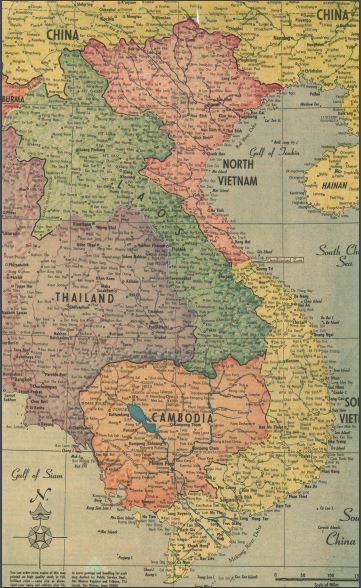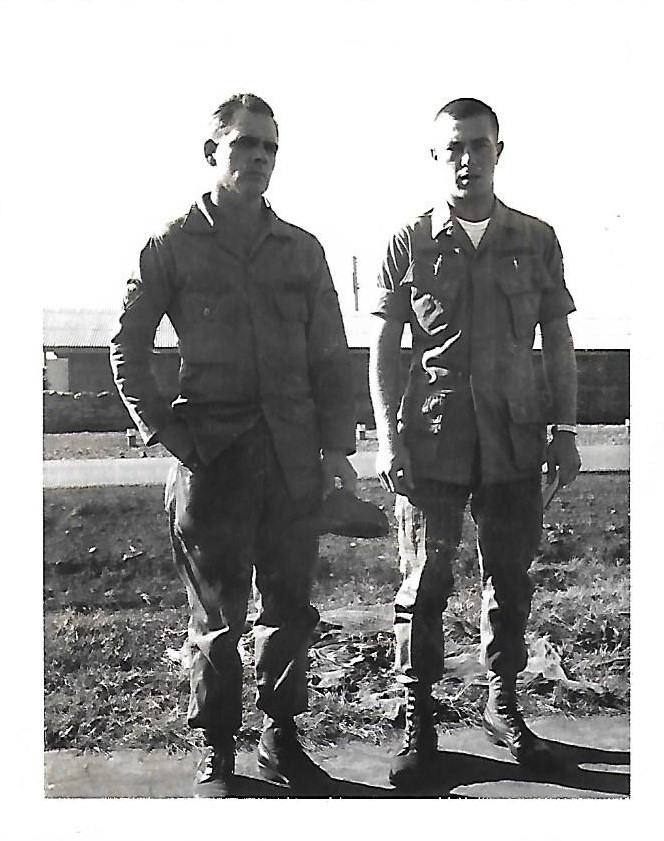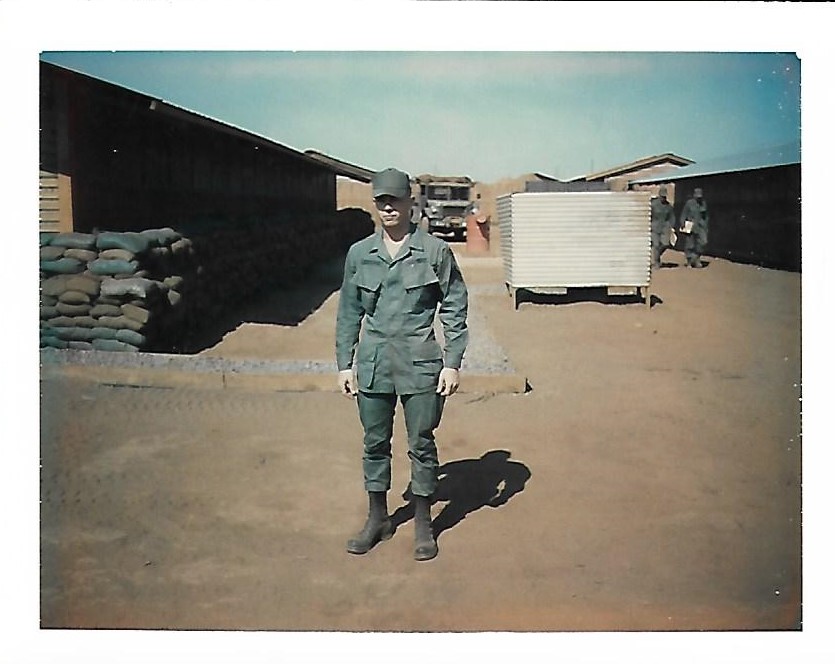Early Life and Enlistment
George Bargman was born in 1945 to a farming family in northern Iowa. In 1966, at the age of 20, he enlisted in the Army. After completing boot camp at Fort Leonard Wood, George went to armored tank school in Fort Knox. While traveling to Fort Knox, George got married on a three-day pass.
After completion of armored tank school, George was sent to Bad Hersfeld, Germany. While in Germany, George was tasked with patrolling the German-Czechoslovak border (radar and ground surveillance), a task which was made difficult because of the disparity between American Jeeps and the Mercedes across the border.
Vietnam
Exactly one week prior to George receiving his orders to go to Vietnam, he had learned that Linda was pregnant, the couple’s first child. If George had not enlisted, he could have appealed for a 3-A deferment, which was offered to fathers and men with pregnant wives or significant others. This deferment was only offered from 1963 until 1970. The whirlwind of news shook the Bargmans. When asked about the experience of being told that George and Linda would soon be having a child and that George would be sent to Vietnam, the Bargmans responded:
Linda: (It was) devastating…
George: It was devastating…it was exciting…I was nervous…um not knowing whether or not I’d come back…I was scared.
George and Linda Bargman on receiving news of Linda’s pregnancy and George’s orders to go to Vietman
George was sent to Vietnam in January of 1968, along with some of the soldiers he had worked with in Germany. As a sergeant in the 4th Infantry Division, George was stationed near the Ho Chi Minh Trail, in the Central Highlands (located in central South Vienam on the border with Laos and Cambodia–see Kontum and Dak To). As a Sergeant, George felt an obligation to keep his squad safe from danger, a near impossible feat in the treacherous region.

Despite the desire to keep his men safe, George often found himself in dangerous situations due to orders which came from above. Several issues caused this.
“There were five of us out on one patrol right into Cambodia…and we were not there…supposedly. And we were overrun with North Vietnamese…lost three of my guys. Couldn’t help it, but that’s the way it was.”
George Bargman on being placed in dangerous situation
Communication was an issue. As a Sergeant, George only had a single contact, the Platoon Sergeant. The Company Commander was never present. This was apparently a common occurrence in Vietnam, as other Sergeants admitted to George.
George also cited issues with the missions on which he was sent. He was constantly being sent to take and retake the same hills, which was not only dangerous but also destroyed morale.
“We sat up at the top of these hills, and it was a fight to get up there and after we were there for three days, they took us off the goddamn hill, which didn’t make any sense…guys got killed doing it and staying there…but it was better staying there than killing and getting killed to get back up there.”
George Bargman on repeated missions
This indecisive or inept leadership often caused strains between the non-commissioned officers and commissioned officers, however, George also blamed politics. What President Johnson said to the American public was very different than what was actually happening on the ground in Vietnam. For instance, the missions which occurred in Cambodia ‘did not happen.’ Similarly, the publicized no-fly zones over Cambodia did not exist.
While speaking of President Johnson, George voiced his opinion that if the president were to send necessary troops and resources to Vietnam, the War likely would have been won.
Not only was communication within the Army a problem, but so was communications between branches of the military. Relying only on Army pilots to conduct bombing runs on ‘army targets’ excluded other branches’ pilots from being able to conduct the same runs from safer angles. In addition to this lack of communication, there was little communication of troop movement. George recalled instances where B-52’s dropped bombs dangerously close to him and his squad.
“You call in B-52 strikes a quarter of a mile from you, and they have 500 to 1000-pound bombs, and that lifts you 2 feet off of the ground. Now you tell me how in the hell they can do that without…because it doesn’t hit the damn target. That went on all the time. You didn’t know who was your friend, you didn’t know.”
George Bargman on dangerous bombing runs
During his time in Vietnam, George worked with local Vietnamese forces. George saw these forces as a net benefit to the Army, a viewpoint not shared among many of his superiors, which he attributes to politics. These men spoke English and were willing to genuinely help American efforts in the War. George found that the soldiers who worked directly with these forces approved of their inclusion, while many of his superiors, who did not work with these forces, did not.
On the topic of rules of engagement, George and Linda said:
George: Rules of engagement…you’re there, I’m there, I got a gun, you got a gun. That’s the rules.
Linda: And your imaginary line (Vietnamese-Cambodian border, which troops were ‘not to pass’).
George: There were no rules of engagement.
The initial shock of Vietnam that all soldiers braved was extreme. Coming from the relatively cool Midwestern state of Iowa, George and many others had to adapt to the much warmer and humid jungle climate of Vietnam. With no preparation for the heat and humidity, George and others resigned to wearing just t-shirts and pants in the war zone when possible. This, however, was complicated when soldiers had to move positions, often carrying 65 to 70 pounds of equipment for hours on end.
In addition to the climate shock, soldiers had a litany of other variables to adapt to including active combat, unit cohesion, and the military lifestyle. If soldiers did not adapt quickly, they would often become one of the 50,000 American casualties of the War. George estimated that soldiers had three months to successfully learn, adapt, and develop cohesion within any given group.
“Toward the beginning you were completely tied up with getting your stuff together and learning to survive. If you did not learn that, you were one of the casualties that went to Japan. If you made it alive…which happened to me…it could have been a lot worse than what it was. But, then you had to go from Cambodia and fly on down to Cam Ranh Bay. From Cam Ranh Bay you go to Japan.”
George Bargman on the consequences of not learning to survive in Vietnam
In November of 1968, Richard Nixon was elected to succeed President Johnson. While George did not have the interest or access to much American news, he did learn of President Nixon’s election. At the time, a change in administration was welcome by many soldiers hoping to see change in how the War was conducted. In short, George and many others wanted to see their hands to be set free from behind their backs. Ultimately, Linda stated:
“Nixon didn’t do any better than Johnson.”
Linda Bargman on Presidents Johnson and Nixon’s handling of the Vietnam War.
Return from Vietnam
24 hours before being shipped out of Vietnam, George learned that he would be going home. After 49 hours, George returned to Seattle. At an airport on the West Coast, George dealt with an anti-War protester who spat and hurled unfair and untrue accusations. On this encounter, George said:
“(he called me a) babykiller…spit on all the time…let’s put it this way…he has no front teeth left…I was only going to go through it once.”
George Bargman on his experience in an American airport following his service in Vietnam
After his return to Iowa, George’s friends and family had a much more positive response to his homecoming. George’s homecoming marked the first time he was able to spend extensive time with his firstborn, who was born during George’s time in Vietnam.
Returning to America from an active war zone created a new set of issues for American soldiers. One such issue for many soldiers was Post-Traumatic Stress Disorder (PTSD). George found himself unconsciously yelling “Vietnamese” at his wife and on occasion choked her, believing to be in Vietnam. In his last year of service, George was stationed in Fort Meade, Maryland. During his time in Fort Meade, he spent a lot of time training National Guardsmen, despite his job mainly consisting of logistical operations. Following his service with the Army, George and his wife worked various jobs before George was hired by Vulcan Materials, headquartered in Birmingham, Alabama, where the Bargmans have stayed ever since.
Correspondence Between George and Linda During the War
During the Vietnam War, letter-writing was the main form of communication between soldiers and their family and friends back home. Letters, while historically prevalent, were problematic in the volume that they were sent. With only one post office for every 30,000 soldiers, letters had to be prioritized before taking the transpacific journey.
“I had our son. my parents were there…he didn’t even find out he was a father for 2 days because the Red Cross said death messages had to go first. And it was rough…we were 21 years old.
Linda Bargman on letter prioritization
Only receiving a letter about every three months from her husband, Linda, who was still living in Iowa, reasonably and constantly felt uneasy about the lack of communication. On the times in between receiving letters, Linda said:
“In that timeframe I never knew if he was alive or dead. And so, if I would go into town and I’d see a military officer I’d high tail it back to my mom and dad’s farm because I didn’t want him coming to see me.”
Linda Bargman on fear of bad news
Mental Health and the VA
The Bargmans agree on the necessity of the VA, especially in the field of mental health. War requires that many who see combat also see human atrocities. The ability to cope with these memories both during and after the War, in the opinion of the Bargmans, was not a focal point. The Bargmans know many stories of soldiers who did not cope well and did not receive the help that was needed. The Bargmans, however, question the effectiveness of mental health measures 30 or 40 years after the fact.
“I think if the VA had representatives that you could go and sit down with and talk, I think it wouldn’t have as many people taking their own lives as what they have now. There are too many people that haven’t come to be able to live with that. I don’t know whether it was us putting bodies that were dead along the side of the road and putting diesel fuel on them and burn them. I don’t know. All of that has memories. It gets old…after a certain age, and you go, ‘what did I do?’ ‘why did I do that?’”
George Bargman on mental health and the VA
Looking toward the future, the Bargmans are cautiously optimistic about the VA. Looking into VA nursing homes, the Bargmans see long waiting times of two years, but also see the opportunity of Vietnam War Veterans being the ‘next group of Veterans to be admitted,’ as many World War II and Korean War Veterans are no longer alive. The Bargmans are also impressed by President Trump’s zeal for VA accountability, which has been an increasingly large problem in the recent past
Societal Changes and the Lasting Impact of the War in Vietnam
The lack of adequate healthcare relating to the War for Vietnam veterans led Linda to say that following veterans’ return home, the common sentiment was “thank you for your duty, goodbye.” This sentiment extended to much of society during and following the War.
Welcoming committees, parades, and other symbolic signs of support for veterans of previous wars were missing from post-War America. Instead, many veterans were met in airports by anti-War protesters, whose reach extended to many large cities and universities. The controversial Vietnam Veterans Memorial, a 500-foot black granite wall with the names of fallen servicemembers etched into it. The Memorial has been described as both a ‘black gash of shame’ and a beautiful, moving monument.
“You’ll never be welcomed home the way other people were. People for World War II, that they welcomed home, they had the Korean Conflict. All they had for us was a goddamn wall, and its up there in D.C..”
George Bargman on his return home and the Vietnam Veterans Memorial
Further Readings
https://www.sss.gov/About/History-And-Records/Effects
More on draft deferments during the Vietnam War.
Herring, George C. Americas Longest War: The United States and Vietnam: 1950-1975. Philadelphia: Temple University Press, 1986.
More on the broader landscape of the Vietnam War.
King, Martin, Michael Collins, and Jason Nulton. To War with the 4th: A Century of Frontline Combat with the US 4th Infantry Division, from the Argonne to the Ardennes to Afghanistan. Philadelphia & Oxford: Casemate Publishers, 2016.
More on the 4th Infantry Division’s history, including the Vietnam War.
https://history.army.mil/html/books/076/76-5/cmhPub_76-5.pdf
More on the long-lasting effects of PTSD on Vietnam War Veterans today.

